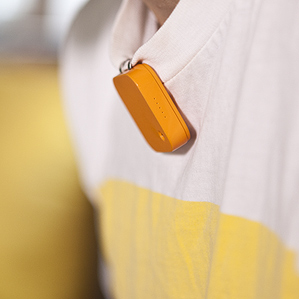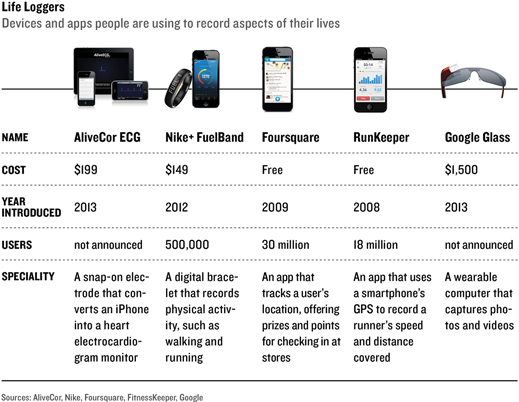Logging Life with a Lapel Camera
“We want to provide people with a perfect photographic memory,” says Martin Källström, CEO of Memoto. His startup is creating a tiny clip-on camera that takes a picture every 30 seconds, capturing whatever you are looking at, and then applies algorithms to the resulting mountain of images to find the most interesting ones.

Just 36 by 36 by 9 millimeters, the inconspicuous plastic camera has a lot crammed inside. The most important component is a five-megapixel image sensor originally designed for mobile phones. An ARM 9 processor running Linux powers a program that wakes the device twice a minute; takes a picture and a reading from the GPS sensor, accelerometer, and magnetometer; and promptly puts the device back to sleep.
Later, when you get home, you plug the camera into a computer to download the pictures. If you like, the process stops here, but if you subscribe to the company’s cloud storage service, things get more interesting. The pictures are fed through an image-processing algorithm that starts to sort out the events in your day. The images are clustered by their predominant colors, and then “we get a diagram of how varied the colors are over the day,” says Källström, whose 17-person company is based in Linköping, Sweden.
That processing turns your photos into “moments”—between 30 and 35 things that have happened during your day, displayed as stacks of photos in a smartphone app or on the Web. Hours spent in front of a computer add up to one moment, a quick coffee break to another. Each is represented by a single sharp, colorful frame—if possible, one with people in it. “It allows you, in the app, to see the good parts of your day with the boring parts hidden,” says Källström.
It’s this clever filtering system, Källström believes, that makes the Memoto more than just a camera. He calls it a “life logging” device that will help people remember what they’ve seen and experienced, or even keep a record for their descendants. “I’d like to be able to put in my will what parts of my life log are going to be available for people that come after me,” says Källström. “I’ve always been fascinated by ways to effortlessly document life.”
Källström, a 37-year-old software developer, came up with the Memoto concept in 2011 and began working on it full time the next year with partner Oskar Kalmaru and product designer Björn Wesén. Last fall, the team raised $550,189 from the public on the crowd-funding site Kickstarter, where they promised a camera to anyone who paid $279 up front.
That was far more than the $50,000 they had expected to raise. “We realized that we were going to have to build more cameras,” says Källström, with typical Swedish understatement. He says that despite some unexpected delays developing and producing the cameras, he expects the first 5,000 to arrive later this year from Taiwan, where they are being assembled.

Life logging is quickly becoming a significant business as consumers embrace wearable self-tracking devices such as Nike’s FuelBand, a bracelet that measures a person’s movements and estimates calories burned. Sharing photos on services like Instagram or Facebook can also be considered a kind of life logging. “It’s already mainstream,” Källström says.
Many large technology companies are considering how to use wearable devices to collect even more personal data. Google, for instance, is now testing a head-mounted computer that can shoot video (see “Google Wants to Install a Computer on Your Face”).
Recording devices that take photos, like Memoto, are going to challenge social norms and raise new privacy questions. When does recording your own life intrude on someone else’s? Stephen Wolfram, creator of the software Mathematica, has been testing an early Memoto prototype since March and says, “It’s still a little bit socially weird.” He adds, “I’m not completely sure what to do with the data, and it does generate a lot of data.”
During a 16-hour day, the camera could snap 2,000 photos and generate about two gigabytes worth of files (the device’s flash memory has room for eight gigabytes). Wolfram says that while flipping back through the pictures, he’s been able to read name tags of people at conferences whose names he’d forgotten. “I can see all kinds of stuff I didn’t notice when I was actually there,” he says.
Memoto is designed to automatically stop taking pictures if it’s taken off and placed on a flat surface, or put in a dark place like a pocket. Källström admits there are certain times when it’s probably best to leave it at home. “Technology forces us to make new kinds of ethical judgments,” he says.
The company’s business model is to sell the devices and charge about $8 per month for online storage of people’s photos. “It’s a lot like a mirror in your bathroom, perhaps,” he says. “You look into it in the morning, and you know a little bit more about yourself.”
Keep Reading
Most Popular
Large language models can do jaw-dropping things. But nobody knows exactly why.
And that's a problem. Figuring it out is one of the biggest scientific puzzles of our time and a crucial step towards controlling more powerful future models.
The problem with plug-in hybrids? Their drivers.
Plug-in hybrids are often sold as a transition to EVs, but new data from Europe shows we’re still underestimating the emissions they produce.
Google DeepMind’s new generative model makes Super Mario–like games from scratch
Genie learns how to control games by watching hours and hours of video. It could help train next-gen robots too.
How scientists traced a mysterious covid case back to six toilets
When wastewater surveillance turns into a hunt for a single infected individual, the ethics get tricky.
Stay connected
Get the latest updates from
MIT Technology Review
Discover special offers, top stories, upcoming events, and more.